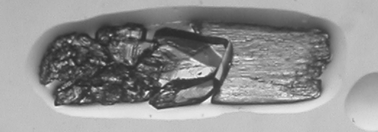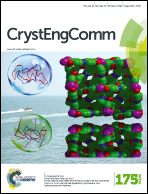Single crystals that spontaneously spawn other single crystals: a ternary and a binary adduct of thiourea and 2,5-dimethylpyrazine†‡
Abstract
Liquid diffusion of n-pentane into a solution of thiourea in 2,5-dimethylpyrazine led to a crystalline 4 : 3 adduct (1), in which corrugated thiourea layers are crosslinked with pyrazines. Attempts to obtain adducts with other stoichiometries, by crystallizing thiourea from a mixture of 2,5-dimethylpyrazine and methanol, formed the ternary 1 : 1 : 1 adduct 2 instead. Adduct 2 displays a layer structure in which parallel thiourea ribbons are linked on the one side by pyrazines and on the other side by methanol and pyrazines, leading to repeating crosslink sequences (⋯thiourea⋯methanol⋯pyrazine⋯methanol⋯thiourea⋯pyrazine⋯); the ribbons within a layer are thus unequally spaced. In inert oil, individual single crystals of 2 spontaneously convert to several smaller crystals, some single, of 1. The process may be regarded as a single-crystal to single-crystal transformation, although not in the usual sense. The 4 : 3 adduct (3) of thiourea with 2-methylpyrazine is isotypic to 1. In all three structures, the preponderant secondary interactions are classical hydrogen bonds.


 Please wait while we load your content...
Please wait while we load your content...